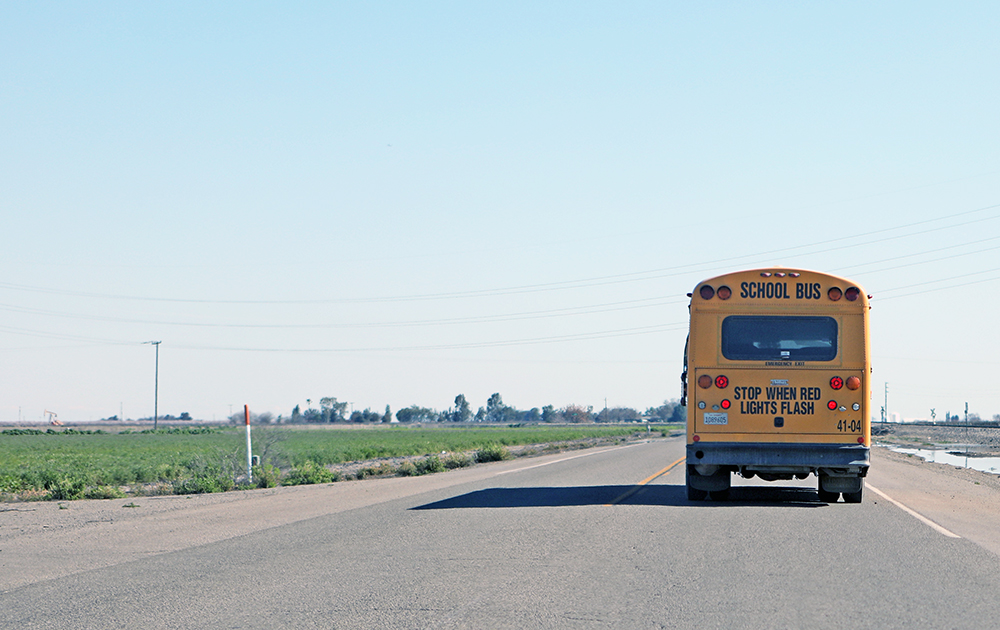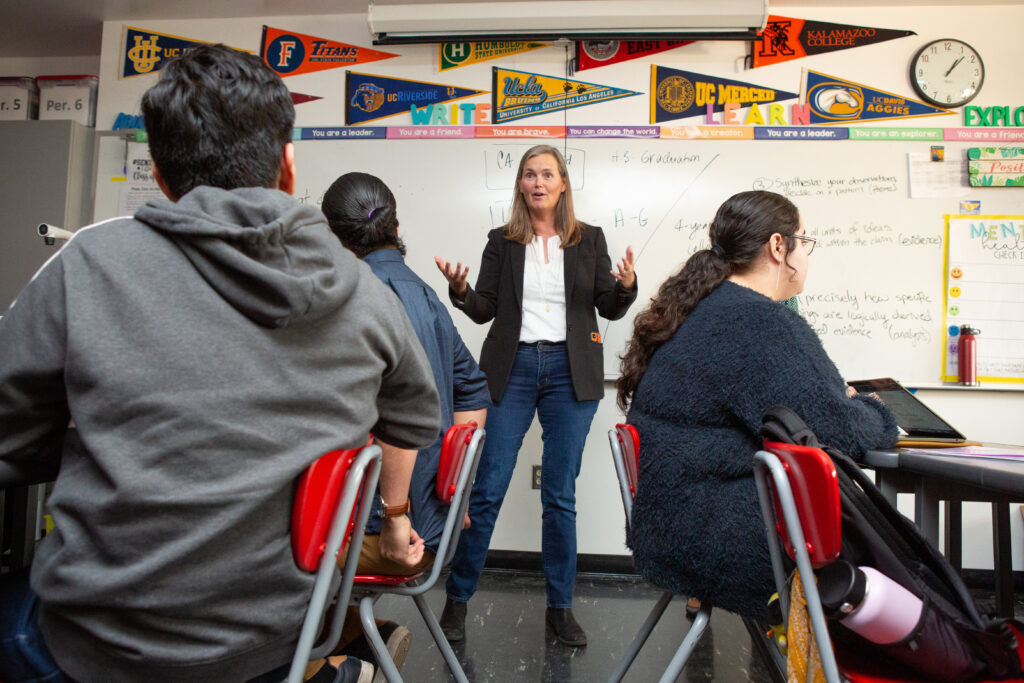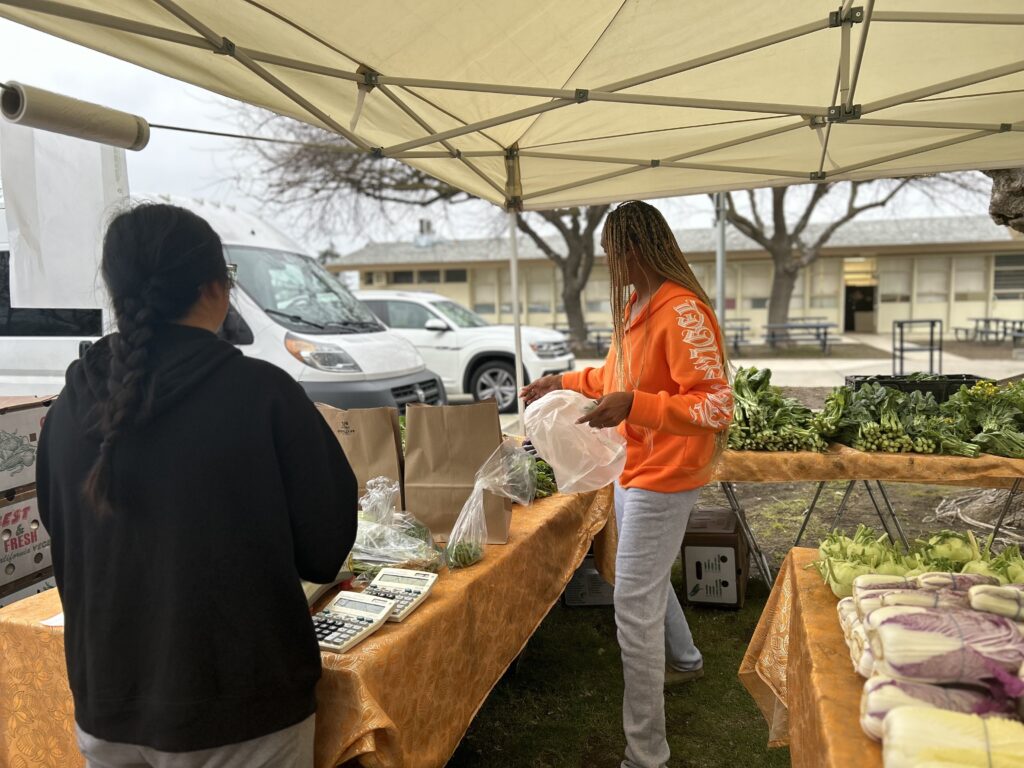
Credit: Fermin Leal / EdSource
While California’s school truancy law remains on the books, school districts in recent years appear to have become less and less likely to enforce punitive measures against parents.
Multiple phone calls, emails, letters and requests for meetings are what parents should expect if their child is deemed truant. If those steps don’t get the child back into school, state law gives districts the right to take parents to court.
But how often that happens is up to school officials and prosecutors and, clearly, officials say, the times have changed. Punitive measures have been shown to be less effective, especially if the reason for the child missing school is beyond the parent’s control.
While parents have been arrested in California for their children being habitually absent from school, it is unclear how many cases resulted in criminal charges. According to state law, a district can declare a student truant and refer them to the district attorney after three unexcused absences of more than 30 minutes during the school year, potentially facing fines and even jail time.
“It’s fair to say that most districts go beyond what the law requires in terms of trying to address these challenges internally at the district level prior to engaging the criminal justice system,” said Jonathan Raven, assistant CEO of the California District Attorneys Association.
State law gives prosecutors wide discretion over how to charge parents when their child is truant, from an infraction, akin to a traffic violation, to a misdemeanor, contributing to the delinquency of a minor.
Chronic absenteeism in California schools is part of a national crisis over children missing school, especially during the pandemic. In California, the percentage of chronically absent students skyrocketed from the pre-pandemic rate of 12.1% in 2018-19 to 30% in 2021-22, after the pandemic. The percentage dropped to nearly 25% in 2022-23.
The state’s truancy law grew out of Kamala Harris’s efforts as a prosecutor to stem the number of high school dropouts who ended up in the criminal justice system.
In San Francisco, where she was the district attorney from 2004 to 2010, she implemented a truancy initiative that introduced the threat of prosecution of parents and guardians when children habitually missed school. That initiative became the model for a 2010 state law that Harris sponsored which adopted strict penalties for parents of truant students: a fine not to exceed $2,000, jail time not to exceed one year, or both.
The penalties could be applied if a student was habitually truant, meaning they missed 10% or more of the school year and only after parents had been offered a range of support services to address the student’s truancy. Truancy courts were created where the penalties could be deferred so long as the students begin attending school. While attorney general from 2011 to 2017, her office created an on-line truancy hub with truancy reports from 2013 to 2016.
The first arrests under the law were in 2011 of five parents in Orange County. The arrest option has since become controversial as districts focus first on how to solve the problems leading to truancy. During her 2019 presidential campaign, Harris stood by the goals of the law but insisted in a podcast interview at the time, that she “never sent a parent to jail” when she was a district attorney. Even though the 2010 state law specifically changed the penal code to include fines and jail time as potential penalties in truancy cases, she said in the same 2019 interview that she regretted knowing some district attorneys had criminalized parents under that state law.
California’s law specifies that with students who are habitually truant, the goal is to keep young people out of the juvenile justice system and in school.
State education law lists over a dozen reasons for excusing students from school, but most excused absences, school officials say, are related to illness and mental health. Unexcused absences often mean that students lacked documentation such as a note from a doctor, or that they provided no reason for their absence or that the reason they provided does not qualify as an excusable absence.
While six out of 10 absences were excused during the 2022-23 school year, four out of 10 were unexcused, state data shows. Both numbers were similar to pre-pandemic levels. The 2023-24 data has not yet been released.
A case study in Santa Clara County
In Santa Clara County, just south of San Francisco, for example, a prosecutor from the district attorney’s office speaks with parents at the start of the school year.
“I go to back-to-school nights to speak not about the law and its consequences, but about attendance and its importance, and particularly attendance in the earliest grades,” said Alisha Schoen, community prosecutor for Santa Clara’s district attorney’s office.
Educators and researchers highlight targeted and constant communication with families — such as phone calls, emails, texts, letters and direct, in-person contact — as a powerful solution to chronic absences. In Santa Clara County, school districts conduct home visits if a student is near truancy.
If that communication doesn’t result in the student attending school regularly, the family is then referred to the local student attendance review board, SARB. The SARB will open a case during which the family must sign an attendance contract stipulating their child will attend school regularly.
With methods in place to help students return to school, attendance issues are most often solved at the school or district level, said Schoen.
But if the student continues missing school, despite all interventions, the student attendance review board then has the discretion to send the case to the local district attorney’s office, at which point the parents could be prosecuted.
Those cases go to Schoen, who might either issue the parents an infraction, like a traffic violation, which is not punishable with jail time but could carry a fine, or decide that the district or school must take additional action in addressing the absences prior to involving the court.
“The cases that I file in my court are almost always cases where the parents refused to come to the school site meeting, did not come to the SARB, didn’t answer the door at the home visit, so this is the necessary step to get them to the table so that then we can talk about the problem and offer supportive services,” Schoen said.
Upon being issued the infraction, the parents then enter what Santa Clara County calls a collaborative truancy court, through which they offer students and their parents access to a county behavioral health social worker, enroll parents in a 10-week in-person or online parenting class, and assign a caseworker to families who might be experiencing far-reaching challenges such as homelessness or unemployment.
“Our throughline is that truancy is a red flag that tells us this child or their family are experiencing some crisis, and we have to recognize that red flag as such, and then get the supportive services to the family to address that underlying crisis so that the attendance can then improve,” said Schoen.
Schoen described how they issue infractions, for example, not misdemeanors; if parents plead guilty, they request the lowest possible fine; and they make every effort to dismiss the case to avoid fines.
“We don’t believe that assigning a large fine will improve their child’s attendance, and it could possibly have a negative effect,” said Schoen.
Of over 234,000 students enrolled in Santa Clara County during the 2023-2024 school year, Schoen’s office heard 130 truancy cases — although some of those cases were from the previous school year. Infractions were issued to 34 parents; 28 were dismissed as student attendance improved, and six parents pleaded guilty. Those six were issued fines, and their court fees were waived. The remaining cases will be continuing this year.
In the past, some counties are known to have taken a more punitive approach.
Merced County in 2017 initiated an anti-truancy effort that included the arrest of 10 parents for failing to send their children to school. They were charged with misdemeanors, contributing to the delinquency of a minor.
Jennifer McHugh, a deputy district attorney in Yolo County, considers it “very unlikely” that she would support jailing parents in truancy cases because once the case is over, “have you really solved the problem?”
In the last year, McHugh got school district referrals for 15-20 students who were excessively truant.
“In the past year, it’s only been one district that’s sent me names of truant students, and I don’t think they’re sending me everyone who’s been truant three or more times, because those would be way more people,” said McHugh. “They’re sending me the people who are excessively truant, you know, 60, 70, 80% of the time that this child’s truant kind of cases.”
Those students and their families entered mediation with the district attorney’s office. During mediation, McHugh meets for 30 minutes to an hour at the county office of education — “a neutral place,” she said — to sign an attendance contract. The meeting includes the student, their parents, McHugh, student support services from the district who have made previous contact with the parents, and others with direct knowledge of the student’s situation.
The point of the contract is not perfect attendance; rather, “good enough” attendance is what McHugh is looking for in order to avoid further court involvement. It’s up to every district to decide when to prosecute.
“My perspective on it is we’re trying to resolve the issue. We’re trying to get them into school,” she said.
Of the 15-20 students in mediation, only two cases were filed against parents. In one case, the student began attending school and the case was dismissed. The second case is pending.
Impacts of targeting chronic absenteeism
While the law stipulates that students with many absences are truant, language today describes the problem as chronic absenteeism, a situation that can be fixed with the proper supports. Another issue is who is targeted when district attorneys get involved in fighting truancy or chronic absenteeism.
“The problem is having kids being labeled unexcused, it’s not equally distributed,” said Hedy Chang, executive director of Attendance Works, a nonprofit that works to improve student attendance.
Her research on unexcused absences, published last year in a PACE report, also found that California “schools serving more socioeconomically disadvantaged students communicate more punitive approaches.”
Certain demographics of students are more likely to have unexcused absences: Black, Native American, Latino, and Pacific Islander, regardless of socioeconomic status, along with low-income students, the study found.
Schools serving students who are socioeconomically disadvantaged were far more likely “to publish policies stating that truancy would result in suspension of driver’s licenses, loss of school privileges like extracurricular participation, and Saturday school or in-school detention,” the report said.
The researchers reviewed the school handbooks of 40 California middle and high schools — half of the schools had a population of over 90% of socioeconomically disadvantaged students and the other half had a population of less than 50% of socioeconomically disadvantaged students.
There are some biases in the system “around how absences are treated and who gets labeled unexcused,” Chang told EdSource. “And sometimes that’s because we don’t have the supports and resources to really do outreach to families.”
She added, “When the truancy laws got created, you didn’t have chronic absence even as a metric or even as an accountability metric for schools, and by having chronic absence as an accountability metric, you are saying: ‘Hey, schools, you’ve got to do something about this.’ So it’s not just the court system that has evolved over time. There is a pretty broad standing consensus that you want to invest in prevention first and you use a legal system as a last resort.”









